The Great Salt Lake and its islands offer stunning scenery and fun recreational activities. But, a favorite among many visitors is the sunsets because of their breathtaking beauty. Imagine the most vivid orange, red, magenta, and lavender hues painted across the sky, slowly dissolving as the darkness inches nearer. Sailors enjoy the lake’s turquoise waters, while swimmers and sunbathers take advantage of its white sandy beaches. It is also the largest saltwater lake in the Western Hemisphere. Furthermore, Great Salt Lake is surrounded by wetlands supporting various wildlife, including snakes. Below is a list of 7 snakes you might encounter at Great Salt Lake, and if any are venomous.
Snakes You Might Encounter at Great Salt Lake
Over 30 snake species exist in Utah, and several species occur around the Great Salt Lake, of which two are venomous.
1. Valley Garter Snake (Thamnophis sirtalis fitchi)
Valley garter snakes inhabit Utah’s central, northern, and eastern regions. They are typically 1 to 2 feet long, but some measure around 4 feet. Valley garter snakes hunt with their incredible sense of smell and heat sensitivity. These snakes have a varied diet, eating small mammals, birds, fish, amphibians, and earthworms. Valley garter snakes prefer to live in wet environments and are active during the day and night. They are very good swimmers and often occur in riparian habitats like rivers, streams, and wetlands.
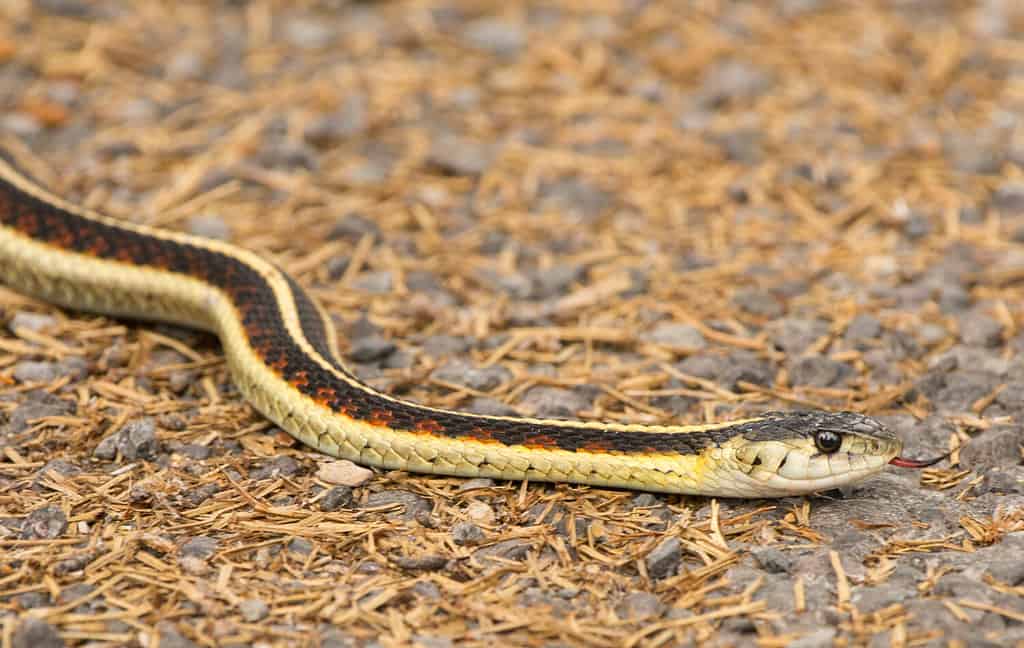
Valley garter snakes inhabit Utah’s central, northern, and eastern regions. They are typically 1 to 2 feet long, but some measure around 4 feet.
©Jennifer Bosvert/Shutterstock.com
2. Terrestrial Garter Snake (Thamnophis elegens ssp.)
People find identifying terrestrial garter snakes in Utah challenging because their coloration varies widely. In addition, there are around six subspecies, but some scientists debate this number. These snakes inhabit several habitats, like forests and grasslands. However, they can also survive in mountainous areas up to 13,000 feet above sea level. While they are mainly found on land, terrestrial garter snakes are incredible swimmers, which is why they occur at the Great Salt Lake.
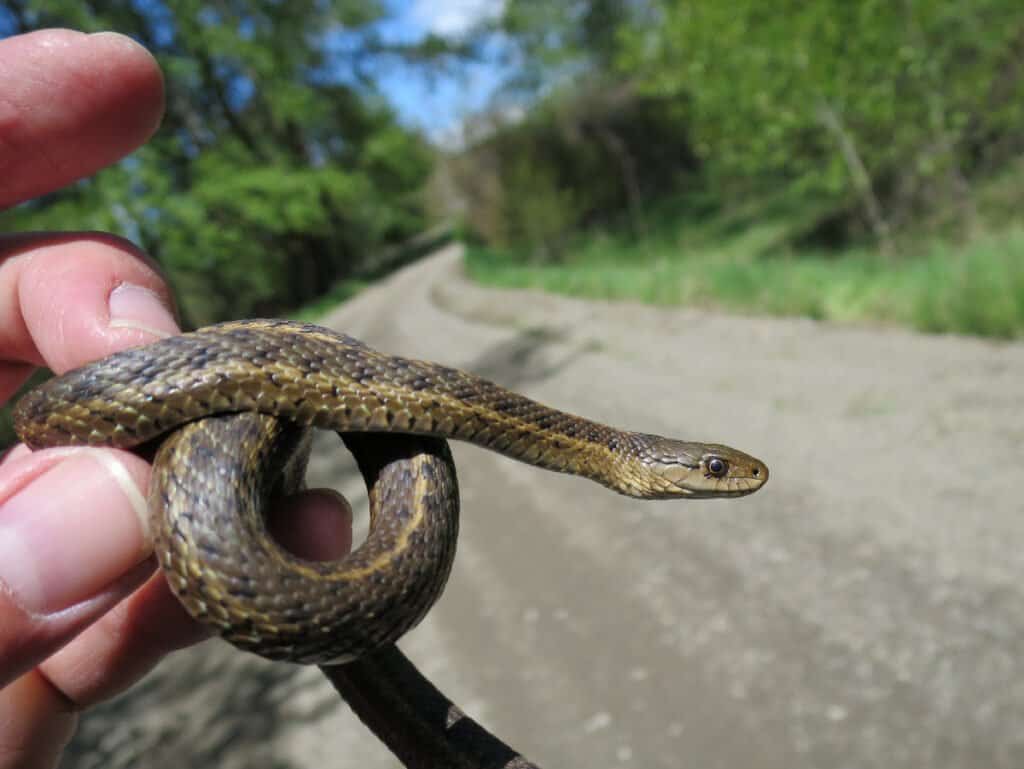
While they are mainly found on land, terrestrial garter snakes are incredible swimmers, which is why they occur at the Great Salt Lake.
©Randy Bjorklund/Shutterstock.com
3. Striped Whipsnake (Masticophis taeniatus)
The striped whipsnake is one of the snakes you might encounter at Great Salt Lake. They inhabit woodlands, grasslands, shrublands, canyons, mountainous areas, and open pine-oak forests. These snakes are diurnal and lightning-quick. They prey on various animals, like young birds, insects, small mammals, lizards, frogs, and other snakes, including rattlesnakes. However, striped whipsnakes are nonvenomous.
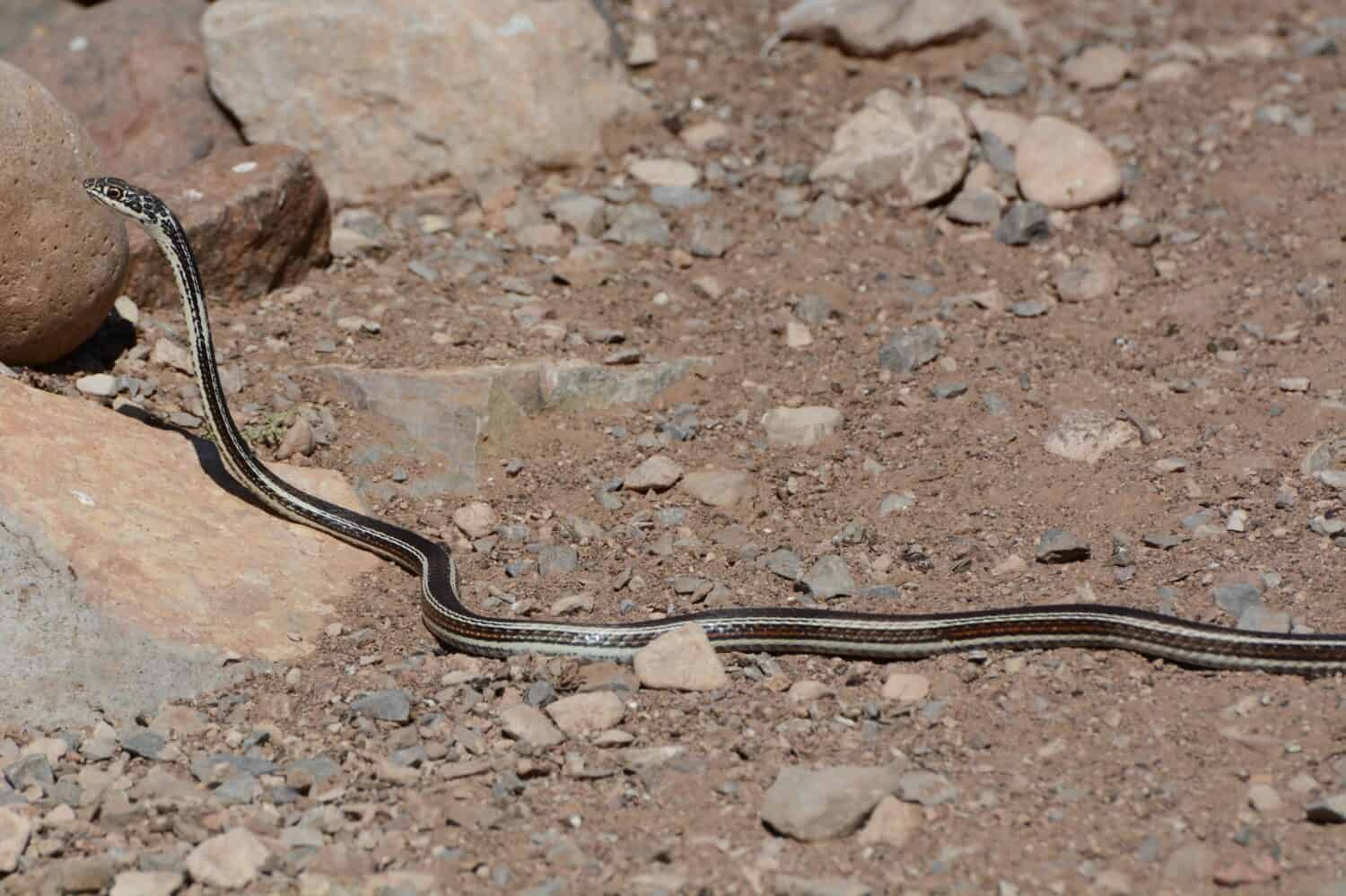
The striped whipsnake is one of the snakes you might encounter at Great Salt Lake. They inhabit woodlands, grasslands, shrublands, canyons, mountainous areas, and open pine-oak forests.
Image: David Jeffrey Ringer, Shutterstock
©David Jeffrey Ringer/Shutterstock.com
4. North American Racer (Coluber constrictor ssp.)
The North American racer is one of the fastest snakes in Utah. They can reach up to 3.5 miles per hour once they get going. North American racers have excellent vision, and they are curious in nature. In fact, they are notorious for raising their heads above tall grass to inspect their surroundings. While their scientific name is Coluber constrictor, they do not actually squeeze their prey to death. Instead, they hold their victim’s body down with their body, subduing it, and they swallow smaller prey alive.
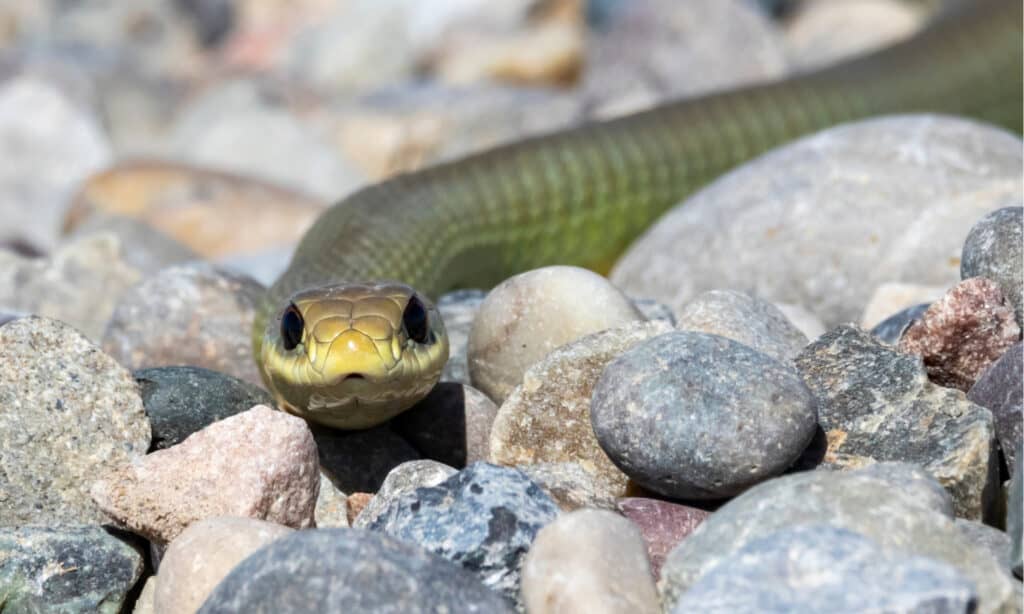
North American racers have excellent vision, and they are curious in nature. In fact, they are notorious for raising their heads above tall grass to inspect their surroundings.
©Michael Chatt/Shutterstock.com
5. Great Basin Gopher Snake (Pituophis catenifer deserticola)
This impressive snake is the largest species of snake in northern Utah, and they are one of the snakes you might encounter at the Great Salt Lake. Great Basin gopher snakes can grow to a whopping six feet long. However, they are constrictors and nonvenomous. In Utah, these snakes are known as blow snakes because when threatened, they inflate their bodies and release the air, which makes a loud hissing sound. Another defense mechanism is their tendency to shake their tails, mimicking rattlesnakes. They are primarily active during the day but will hunt at night if it’s too hot. Great Basin Gopher snakes don’t prey on other snake species, but they do hunt lizards. However, their favorite prey is rodents.
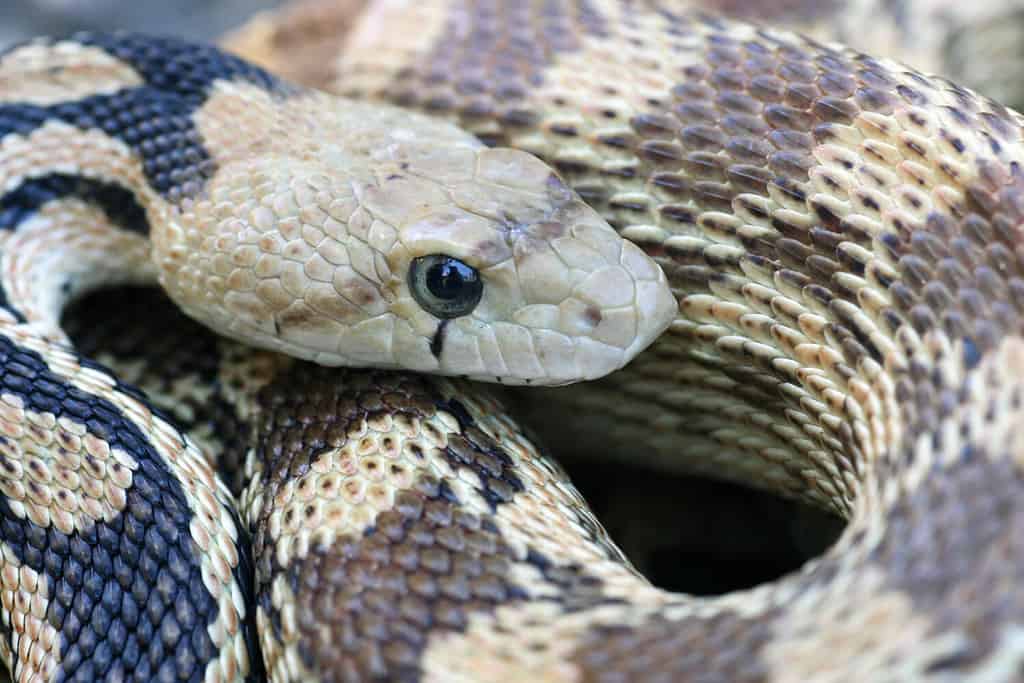
Great Basin gopher snakes can grow to a whopping six feet long. However, they are constrictors and nonvenomous.
©Michael Benard/Shutterstock.com
6. Great Basin Rattlesnake (Crotalus lutosus)
The Great Basin rattlesnake is one of the venomous snakes you may encounter at Great Salt Lake. They occur in several habitats, including open mountain forests, prairies, and deserts. While they primarily live on the ground, these snakes occasionally climb trees. The Great Basin rattlesnake’s diet consists of animals like birds, small mammals, lizards, and sometimes frogs.
When subduing their victim, these rattlesnakes inject them with venom. However, humans rarely die from Great Basin rattlesnake bites. But that does not mean you shouldn’t seek medical care when bitten. Great Basin rattlesnake venom causes internal bleeding, and if not treated, it can result in pulmonary edema, a condition caused by too much fluid in the lungs, or heart failure.
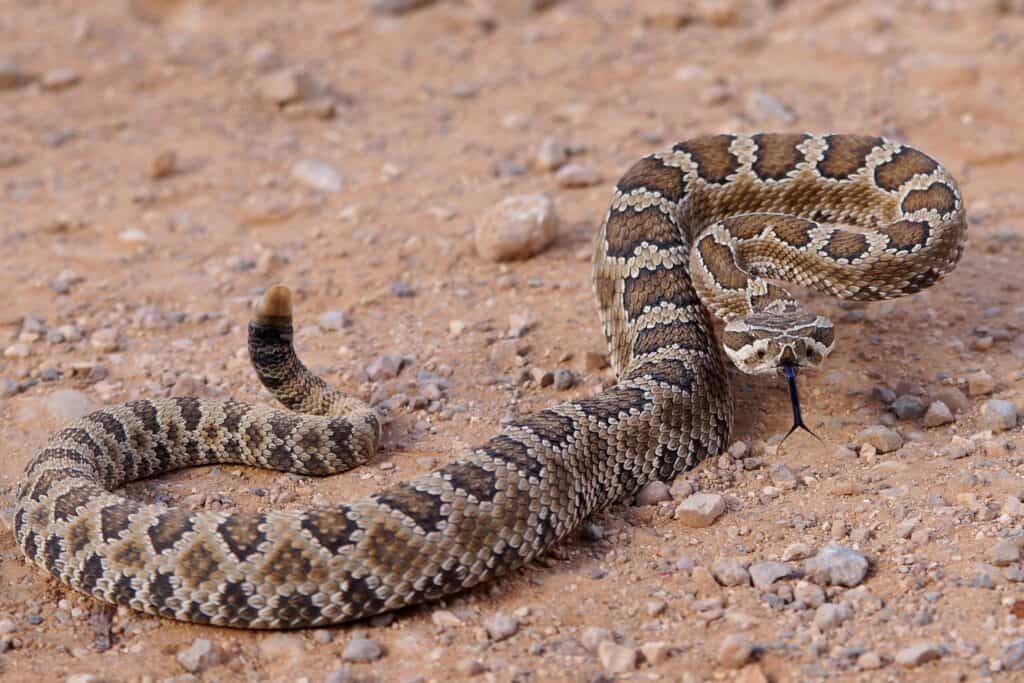
The Great Basin rattlesnake is one of the venomous snakes you may encounter at Great Salt Lake. They occur in several habitats, including open mountain forests, prairies, and deserts.
©Matt Jeppson/Shutterstock.com
Other Animals Found at Great Salt Lake
The areas surrounding the Great Salt Lake are teaming with wildlife, especially deer species. The Great Salt Lake Shorelands Preserve covers 4,400 acres of wetlands along the lake’s eastern edge. This preserve provides over 250 bird species with important nesting and foraging habitat. But birds are not the only animals in this area. Below is a list of some of the wildlife found around the Great Salt Lake:
- Moose
- Wapiti
- Mule deer
- American bison
- Pronghorn
- Mountain goat
- Long-tailed weasel
- Bobcat
- Mountain lion
- Kit fox
- Green frog
- Northern leopard frog
- Northern Harrier
- Bald eagle
- Common raven
What to Do When You Encounter a Snake At a Lake
If you happen to spot a snake while visiting a lake or in the lake, the first rule is to keep calm. Snakes don’t usually attack humans for no reason. So, as long as you leave it alone, it shouldn’t hurt you. However, if the snake is venomous, it’s best to alert Salt Lake City Animal Services at (385) 468-7387. Furthermore, you should inform other visitors to the area about the venomous snake so they can take extra precautions.

If you happen to spot a snake while visiting a lake or in the lake, the first rule is to keep calm. Snakes don’t usually attack humans for no reason.
©Jacob Boomsma/Shutterstock.com
The photo featured at the top of this post is © iStock.com/Zhi Gong
Discover the "Monster" Snake 5X Bigger than an Anaconda
Every day A-Z Animals sends out some of the most incredible facts in the world from our free newsletter. Want to discover the 10 most beautiful snakes in the world, a "snake island" where you're never more than 3 feet from danger, or a "monster" snake 5X larger than an anaconda? Then sign up right now and you'll start receiving our daily newsletter absolutely free.
Thank you for reading! Have some feedback for us? Contact the AZ Animals editorial team.







